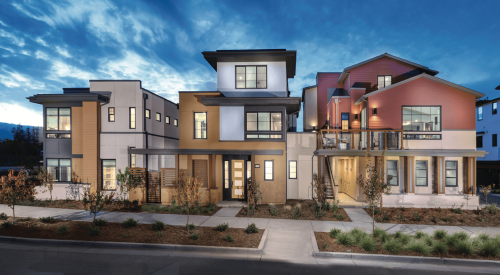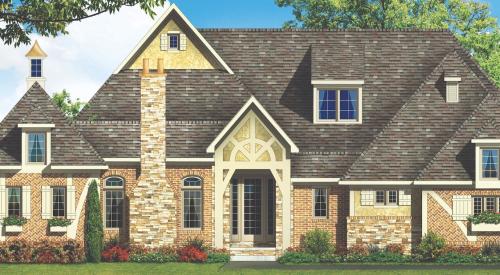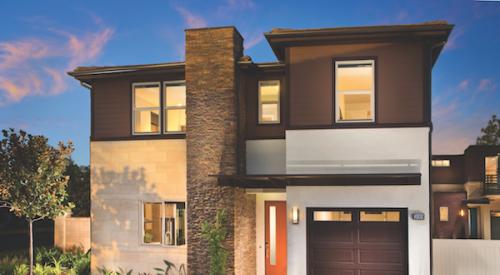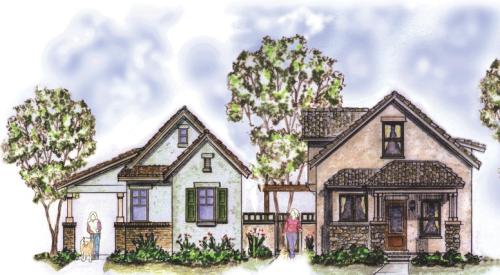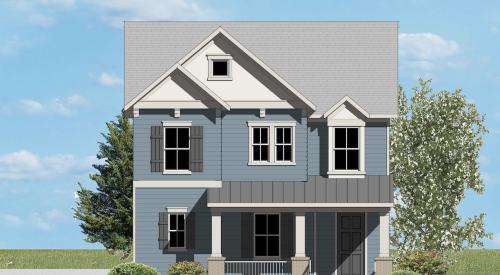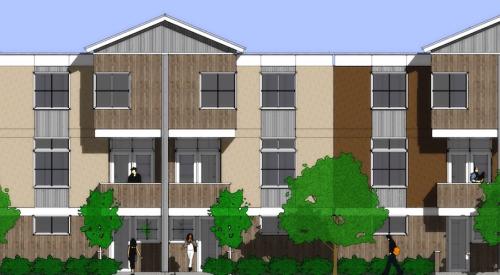 |
|
Lendry Homes' Newberry plan at Amelia Island, Fla., adds a stairway and porch to a granny flat atop its three-car garage.
|
 |
|
Some accessory units live like studios with one large room, while others live like conventional homes. This Quincy model (above and below) from Lendry's Amelia Park project treats the accessory unit as a full home — not an afterthought. On the other hand, there are cases where flats are left open to meet flexible buyer uses.
|
 |
Accessory units, or living spaces that are secondary to the main home, are enjoying a resurgence in popularity. Also called "granny flats," especially when located above a detached garage, these units have unique advantages for the builder and the buyer. (See Taking Granny (Flats) To Market)
From a design point of view, builders should consider two main aspects: the site and the floor plan.
Maximize the Site
A home at the front of the lot and the granny flat to the rear can create a useable courtyard in between and "accentuate the outdoor lifestyle," says architect Alan Menzies, principal of design at William Hezmalhalch Architects. "The wider the lot, the better," he adds, "so you can provide more privacy for the owner and the renter. The biggest challenge is privacy," Menzies says.
A pair of two-story structures on a lot, however, needs to be treated very carefully to prevent them from competing with each other or overwhelming the site. At Centex Homes' Los Olivos at Wetmore Ranch in Livermore, Calif., which was designed by Menzies and William Hezmalhalch, Plans 3 and 5 both meet that challenge. Each offers a granny flat and uses a porte-cochere to achieve the right massing.
Porte-cocheres were used in carriage days as a covered side entrance leading from the drive into the house. At Los Olivos, the porte-cochere balances the larger garage/granny structure in the back by bringing the smaller element up front on the 75 x 130-foot (Plan 3) and 95 x 130-foot (Plan 5) lots.
The layouts using this feature deliver a layered look to the street, and they also also add a sense of privacy by limiting views into the motor court and adjacent side yard.
Dawn Michele Evans, vice president/director of marketing for the architecture firm The Evans Group in Orlando, cautions that corner lots take special consideration, too. "The architecture of the house needs to wrap the corner," says Evans.
The Evans Group designed for Lendry Homes' Amelia Park, located on Amelia Island, 35 miles northeast of Jacksonville. In the 2,191-square-foot Newberry, which sits on a 55 x 110-foot lot at Amelia Park, a large front porch wraps to the side, drawing the eye around and adding design excitement to the side elevation.
On this particular model, a covered breezeway leads from the house back to the three-car garage and a stairway leading up to the 600-square-foot granny flat. The flat takes a cue from the main home's architecture with a second-story front porch.
More and more lots, especially in Neotraditional communities, call for rear-loaded detached garages. That setup allows for a great lot amenity: the two structures create a totally private rear yard in between them. Alley-loaded design also helps accommodate extra parking — critical if the granny unit is rented out — by limiting or eliminating the need for curb cuts at the front, thereby allowing for on-street parking.
The Newberry plan put a twist on the alley-loaded garage: It side-loads from the alley, making the three-car garage look narrower and less imposing from the street, but sacrificing some yard space in favor of the motor court.
The Ultimate Flex Space
As an extra living area separate from the house, an accessory unit has no set role to play. Like bonus rooms, lofts and flex spaces within the home, this space can serve a number of purposes.
It can even change as homeowners' needs change — making these flats a very attractive addition to the primary home.
"The driver for builders is to get more square footage on the lot," says Menzies. "For buyers, it helps out with growing families, live-in inlaws and kids that move back home but don't want to be under the same roof."
While the term "granny flat" brings an aging relative to mind, a college-age or boomerang child, teenagers or even an unrelated renter are just as likely to live in the space. Or buyers may choose to use the extra space as an at-home office, an art or sewing studio, a kids' hangout or game room.
"We always design flexible floor plans," says Evans. "It can be one big open room with a bath, or divided into a kitchen, sitting room, breakfast nook, bedroom and bath."
At Amelia Park, the buyers often live in the extra space, Evans says. "The development is on an island in a resort community, so buyers can get help paying the mortgage by renting out the house, and then move into the 'big house' when they retire."
If someone will live in the unit full-time or even part-time, the plan needs to include a bedroom, bath and kitchen at least. A studio-style layout with a galley kitchen can suit this quite nicely above at least a two-car garage. A one-car garage would be a pretty tight fit, and few builders build one-car garages anyway. Bump that garage space up to three or four cars, and the options multiply.
Los Olivos Centex offers two configurations on Plan 5, a 4,365-square-foot house with a standard three-car garage. Both variations feature a stairway at the side of the front-facing garage, accessed by a covered breezeway perpendicular to the main home's covered rear porch and leading up to the granny flat. (The plan also offers an option that replaces one of the garage bays with a casita.)
In the bonus-room scenario, one large space runs the length of the flat, with a wet bar and windows on one side and a full bath, closet and two storage spaces (with doors) on the other. Despite having windows on just one side, the wide-open floor plan allows for plenty of light and a variety of uses.
The other Plan 5 configuration packs almost a full architectural program into 582 square feet. While the windowless side of the flat remains the same (bath and storage), the rest of the space divides up into a living room; a small, but full-service kitchen and nook; plus a bedroom. A pass-through between the kitchen and living room creates a feeling of openness.
The Los Olivos Plan 3, a four-car, front-facing tandem, offers even more space — 717 square feet — although a three-car tandem is the standard offering. Its floor plan avoids feeling or looking boxy — and softens the massing on the streetscape — by making the front third of the plan narrower than the garage below.
The side stairway and entry open into a living room with a media niche. To the right is a kitchen with a small eat-in area, as well as a pantry, space for a stackable washer and dryer and storage areas. To the left of the living room (at the front of the plan) is a single bedroom with a small balcony above the garage doors — a nice way to add movement and interest to that plane. A full bath, with a door off the living room, tucks behind the media wall.
Granny flats offer a surprising number of floor-plan options and often can function the same as a small house — if well designed. Keep in mind that an open plan helps the space feel bigger and less compartmentalized and that room functions can be combined to make the best use of space. Take advantage, too, of roof slope, if appropriate, to add volume and interest to the ceiling.
There aren't too many rules for designing this flexible space — after all, this isn't your grandmother's granny flat.
